Lefkosia lies roughly at the center of the island, with a rich history that can be traced back to the Bronze Age. It only became capital of the island in the 11th century AD. The Lusignans turned it into a magnificent city with a Royal Palace and over fifty churches.
Today it blends its historic past brilliantly with the bustle of a modern city. The heart of the city, enclosed by 16th century Venetian walls, is dotted with museums, ancient churches and mediaeval buildings preserving the nostalgic atmosphere of years past. Yet this old heart is split in two, leaving Lefkosia the only capital city to remain divided by force.
New Lefkosia developed outside the walls, and became a contemporary and cosmopolitan business and cultural center. Just a few miles away are enchanting places of interest such as Byzantine churches and monasteries, archaeological sites and charming villages.
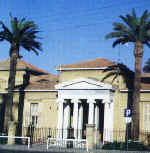
Cyprus Museum
Places of Interest:
Cyprus Museum
Mouseiou 1, Tel: (02) 86 58 64
Priceless and fascinating collection of Cypriot antiquities and treasures from Neolithic Age to the Early Byzantine period are shown here.
Kasteliotissa (Medieval hall)
in front of Pafos Gate
This hall, with its strong Gothic elements, was once part of a Lusignan Palace, which dates back to 13th-14th centuries. It has been restored by Department of Antiquities and today is used as a Cultural Center, open to the public only during Cultural events.
Leventis Municipal Museum of Nicosia
Ippokratous 17, near Laiki Geitonia, Tel: (02) 66 14 75
Historical museum of Lefkosia revives life in the capital, from ancient times to the present day.
Byzantine Museum and Art Galleries
Archbishop Makarios III Foundation Cultural Center within the Archbishopric, Plateia Arch. Kyprianou, Tel: (02) 43 00 08
Largest collection of icons on the island, covering the period from 9th to 18th century is shown in this museum. Art Galleries contain oil paintings, maps and lithographs.
Ethnographic Museum of Cyprus
Former Cyprus Folk Art Museum, Founded by the society of Cypriote Studies
Plateia Arch. Kyprianou, Tel: (02) 43 25 78
Wide collection of Cypriot folk art of 19th and early 20th century, including wood-carved objects, tapestry, embroidery, pottery, national costumes and hand-woven materials are shown here.
National Struggle Museum
Near the Archbishopric, Plateia Arch. Kyprianou, Tel: (02) 30 45 50
Documents, photos and other memorabilia of 1955-1959 National Liberation Struggle are shown.
Agios Ioannis Cathedral
Within Archbishopric area, Plateia Arch. Kyprianou
Built by Archbishop Nikiforos in 1662, 18th century wall paintings depict scenes from Bible and discovery of the tomb of Saint Barnabas at Salamis. Dedicated to Agios Ioannis Theologos (Saint John the Theologian).
Archbishopric (Old and New)
Plateia Arch. Kyprianou
Center of Cyprus Orthodox Church, the new Archbishopric was built in a neo-Byzantine style in 1960. The Old Archbishopric houses Ethnographic museum of Cyprus.
House of Chatzigeorgakis Kornesios
Patriarchou Grigoriou 20, near Archbishopric, Tel: (02) 305316
It is the most important 18th century building in Lefkosia, which after being restored, won 1988 Europe Nostra Award. Once the residence of Dragoman Chatzigeorgakis Kornesios, it now houses Cyprus Ethnological Museum.
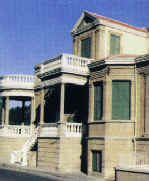
State Gallery of Contemporary Cypriot Art
Cyprus Postal Museum
Agiou Savva St. 3B, Tel: (02) 30 47 11
Collection of Cyprus stamps from 1800 onwards. These stamps, classified internationally amongst the best, are of significant value in world philately.
Cyprus Jewelers' Museum
Praxippou 7-9 Lefkosia, Tel: (02) 66 72 78
A display of traditional jewelers from the end of the 19th century including ornaments, religious items, silver utensils and old tools.
Famagusta Gate
Leoforos Athinon, Tel: (02) 43 08 77
Venetian walls, which completely encircle the old city have a circumference of 4.5 km and possess eleven heart-shaped bastions. There were only three gates to the city in North, South and East. One of these gates, Porta Giuliana called Famagusta Gate, has been restored and is now Lefkosia Municipal Cultural Center. Vaulted passage and two side rooms are used for exhibitions, conferences, lectures and various performances, with the passage leading to the moat. One of the most typical quarters of the town close to Famagusta Gate is also being rehabilitated.
Nicosia Municipal Arts Center
Apostolou Varnava 19, Tel: (02) 43 25 77
The center is housed in the building of the old power station, which is one of the finest examples of industrial architecture in Cyprus. Its aim is to promote contemporary creativity at its highest level by organizing important and prestigious exhibitions.
State Gallery of Contemporary Art
Leoforos Stasinou and Kritis, Tel: (02) 30 29 51 and 30 29 52
Representative collection of paintings and sculpture by 20th century Cypriots artists are shown.
Chrysaliniotissa Church
Within walking distance from the Archbishopric
Considered the oldest Byzantine church in Lefkosia, it is dedicated to "Our Lady of Golden Flax" and is believed to have been built in 1450, by Queen Helena Palaeologos.
Omeriye Mosque
Trikoupi St. Tillirias Square
It is located near the main Municipal Market, within the walled city. Converted into a mosque in 1571 by Mustapha Pasha, who believed that the original 14th century Augustinian church of St. Mary was built on the spot, where prophet Omer rested, when visiting Lefkosia. Most of the original building was destroyed by Ottoman artillery. The door of the main entrance belongs to 14th century Lusignan building. Remains of a later Renaissance phase of the building could be seen at the Northeastern side of the monument.
Faneromeni Church
Onasagorou St., within the old city
Built in 1872, this used to be the largest church in Lefkosia. The marble mausoleum to the East of the church contains relics of the bishops and priests executed by Turks in 1821.
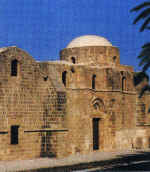
Fikardou village
Trypiotis Church
Solonos 47-49, near Laiki Geitonia
It is an interesting example of Franco-Byzantine style, which was built by Archbishop Germanos II in 1695
Lidra Street Lookout Point
Lidra Street, Shakolas building, Tel: (02) 67 93 69
This offers a panoramic 360-degree view of the town of Lefkosia and is situated on 11th floor of Shakolas building.
Laiki Geitonia
Pedestrian area within the walled city, East of Plateia Eleftherias
Charming winding alleys with traditional houses, shops, restaurants and galleries all lovingly restored as typical examples of Cypriot urban architecture of a bygone, more graceful age.
Chrysaliniotissa Crafts Center
Ipponaktos and Dimonaktos
An interesting complex of eight workshops nestling around a central courtyard, designed on the basis of a traditional inn architectural concept. It accommodates units engaged in contemporary applications of traditional crafts.
Municipal Theatre
Mouseiou, opposite Cyprus Museum, Tel: (02) 49 29 00 and 66 40 28
It is built in a neo-Classical style. Theatre is used for musical concerts, dance performances and various ceremonies. It is also the main venue of Cyprus Theatre Organization.
St. Paul's Anglican Cathedral
Leoforos Lordou Vyronos, Tel: (02) 44 22 41
This parish church, for Anglican residents, was built in 1893, in a style reminiscent of many English village churches.
Cyprus Craft Center
Leoforos Athalassas 186, Tel: (02) 30 50 24
The government-run center aims to promote and enrich traditional folk art and craft skills. It has various workshops and a showroom/shop at its premises, as well as shops in Laiki Geitonia and in all other towns.
Museum of the History of Cypriote Coinage
Stasinou 51. Agia Paraskevi, Bank of Cyprus Headquarters, Tel: (02) 67 71 35
Permanent exhibition presenting the development of coinage of Cyprus from 6th century BC to the present day is shown.
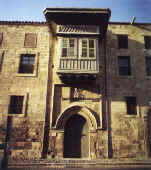
House of Chatzigeorgakis Kornesios
Lefkosia Outskirts:
Five municipalities are situated on the outskirts of Lefkosia. In Aglantzia you could visit Natural History Museum, (Tel: (02) 33 31 41) and Skali Cultural Center, overlooking the area with Pentadaktylos mountain range as a backdrop.
Skali has galleries and lecture theatres in a style that is in harmony with geological formations of the area. Aglantzia also has a number of interesting chapels of 18th century, such as Chapel of Panagia, of Agios Georgios at Skali and Agios Georgios in Athalassa.
Interesting sites in the old sector of Strovolos include Pancyprian Geographical Museum, (Tel: (02) 42 79 29), which is the first of its kind on the island and is housed in a renovated inn, and 18th century church of Agios Georgios.
In Agios Dometios you could visit the church of Agios Dometios, late 17th century, while in Egkomi, there is Panagia of Makedonitissa, Municipal Gallery and Outdoor Museum of Folk Art. In Latsia Gorge of Kakaristra is considered to be an important geological landmark. Tours can be organized by prior arrangements (Tel: (02) 48 84 85).
In Kaimakli,18th century Church of Archangel is worth seeing, as is the church of Agia Varvara, of the end of 19th and beginning of 20th centuries.
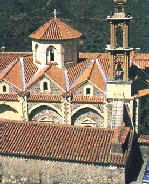
Machairas Monastery
Out of City, Area 1:
Dali Region
About 20 km South of Lefkosia, on Lefkosia-Larnaka/Lemesos road
Remains of all historic periods of the island could be traced in this area. Excavations of Ancient Dali, one of the ancient city-kingdoms of Cyprus, are currently taking place in the town of Dali.
Byzantine church of Agioi Apostoloi could be seen at Pera Chorio. It has excellent examples of wall paintings dating back to the late 12th century, which are considered by scholars as some of the finest examples of Komninian style in Cyprus. An important church in the region is that of Agios Dimitrios (16th century).
Medieval ruins exist around the village of Potamia, namely the ruins of the summer Palace of Frankish kings of Cyprus, as well as those of a Gothic church.
A small technological museum has been set up in nearby village of Agia Varvara (10 minutes from Dali). This village borders upon old copper mines.
Panagia Chrysospiliotissa
Near Deftera village, 11 km Southwest of Lefkosia
Dedicated to "Our Lady of Golden Cave", catacomb structure of the church indicates that it dates back to the early Christian period. A religious fair is held near the church on 15th August, name day of Virgin Mary.
Tamassos
Politiko village, 20 km Southwest of Lefkosia
Tamassos was a rich city-kingdom in ancient Cyprus, renown for its copper mines. Excavations have brought to light Royal Tombs and copper workshops associated with Aphrodite-Astarte.
Agios Irakleidios Convent
Politiko village, 0.5 km from Royal Tombs
When Saints Paul and Barnabas came to Cyprus, Irakleidios, whom they later consecrated as Bishop of Tamassos, guided them to Tamassos. He was martyred and buried in the cave, where he had lived and preached. Monastery, founded in 400 AD, was destroyed and rebuilt several times, until Archbishop Chrysanthos renovated the church and cells in 1773. Relics of the saint are kept in a silver gilt case. Organized groups may visit the convent on Mondays, Tuesdays and Thursdays from 09:00-12:00. Use of photo and video cameras inside Convent is prohibited.
Machairas Monastery
41 km South of Lefkosia, through Deftera and Pera villages
Founded by two monks in 1148, when an icon of Virgin Mary was found in a nearby cave, monastery is set in a picturesque dip in the Machairas Mountains. Following a grant by the Anastasios G. Leventis Foundation, the vestry of Machairas monastery, which is housed in monastery basement, has been renovated and consists of original cells of the monks, as well as stables and storage areas, which were restored specifically for this purpose. Vestry has a room, where Monastery's old books and manuscripts are kept, galleries and rooms containing icons and other religious artifacts.
Brotherhood is extremely devout, keeping vows as strict as those of Mount Athos in Greece.
Organized groups may visit monastery on Mondays, Tuesdays and Thursdays from 09:00-12:00. Use of photo and video cameras inside the monastery is prohibited.
Fikardou
1.5 km east of Gourri village (Machairas-Lefkosia road via Klirou), Tel: (02) 63 47 31
The whole village has been declared an ancient "monument" in order to preserve remarkable woodwork and folk architecture of 18th century houses. Houses of Katsinioros and Achilleas Dimitri, some parts of which date back to 16th century, have been restored as vivid examples of rural architecture. In consequence they received the Europe Nostra award in 1987.
Agios Panteleimon Convent
1.5 km Northwest of Agrokipia village
An 18th century monastery, with gabled roof, now serves as a retreat for three nuns.
Archangelos Michail Convent
Off the Lefkosia-Anthoupolis road, 10 minutes drive from Lefkosia
Church dating back to Byzantine period, was founded by Archbishop Nikiforos, whose tomb could be seen in the narthex of. Rebuilding was carried out in 1636 and in 1713, when Kykkos Monastery purchased it. The iconostasis dates back to 1650 and there is a 1785 fresco of Archangelos Michail. Now, it houses Kykkos Monastery Research Center.
Peristerona
27 km from Lefkosia, on the Lefkosia-Troodos road
Saints Barnabas and Hilarion church founded here, was probably erected in the early 10th century and is an outstanding example of Byzantine architecture, with five domes forming a cross. Next to the church stands Turkish Mosque of Peristerona, witness to the long and peaceful coexistence between Greek and Turkish Cypriots of the village (and the whole of Cyprus) in a time, when Turkey had not yet adopted its partitionist and expansionist policy.
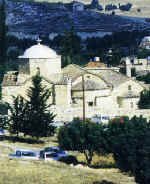
Agios Irrakleidios Convent
Out of City, Area 2:
Machairas Monastery
41 km South of Lefkosia, through Deftera and Pera villages
Founded by two monks in 1148, when an icon of Virgin Mary was found in a nearby cave, monastery is set in a picturesque dip in the Machairas Mountains. Following a grant by the Anastasios G. Leventis Foundation, the vestry of Machairas monastery, which is housed in monastery basement, has been renovated and consists of original cells of the monks, as well as stables and storage areas, which were restored specifically for this purpose. Vestry has a room, where Monastery's old books and manuscripts are kept, galleries and rooms containing icons and other religious artifacts.
Brotherhood is extremely devout, keeping vows as strict as those of Mount Athos in Greece.
Fikardou
1.5 km east of Gourri village (Machairas-Lefkosia road via Klirou), Tel: (02) 63 47 31
The whole village has been declared an ancient "monument" in order to preserve remarkable woodwork and folk architecture of 18th century houses. Houses of Katsinioros and Achilleas Dimitri, some parts of which date back to 16th century, have been restored as vivid examples of rural architecture. In consequence they received the Europe Nostra award in 1987.
Agios Panteleimon Convent
1.5 km Northwest of Agrokipia village
An 18th century monastery, with gabled roof, now serves as a retreat for three nuns.
Archangelos Michail Convent
Off the Lefkosia-Anthoupolis road, 10 minutes drive from Lefkosia
Church dating back to Byzantine period, was founded by Archbishop Nikiforos, whose tomb could be seen in the narthex of. Rebuilding was carried out in 1636 and in 1713, when Kykkos Monastery purchased it. The iconostasis dates back to 1650 and there is a 1785 fresco of Archangelos Michail. Now, it houses Kykkos Monastery Research Center.
Peristerona
27 km from Lefkosia, on the Lefkosia-Troodos road
Saints Barnabas and Hilarion church founded here, was probably erected in the early 10th century and is an outstanding example of Byzantine architecture, with five domes forming a cross. Next to the church stands Turkish Mosque of Peristerona, witness to the long and peaceful coexistence between Greek and Turkish Cypriots of the village (and the whole of Cyprus) in a time, when Turkey had not yet adopted its partitionist and expansionist policy.
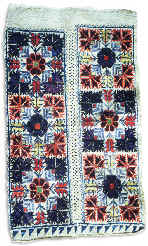
Embroidery, 19th century
Leventis Municipal Museum of Nicosia







